By Michael Barker
Doctrine and Covenants Section 24 (Book of Commandments (BoC) 25 (cf. LDS D&C 24 and Community of Christ (CoC) D&C 23))
Date: [4-31]July 1830
Place: Harmony, Susquehanna County, Pennsylvania
Historical Note: On 9 June 1830 the first conference of the Church was convened in the home of Peter Whitmer, Sr., in Fayette, New York. Immediately after the conference Joseph Smith and others left for Harmony, Pennsylvania. Shortly after arriving home in Harmony, Joseph Smith, Emma, and a few others went to visit the Knights in Colesville, New York, where many believers were baptized. While away from Harmony, Joseph was twice arrested for being were “disorderly”, but both times was acquitted.
Dr. Richard Bushman has this to say about Joseph’s June 1830 arrests:
The nature of the charges brought against Joseph in the court of Justice Joseph Chamberlain of Chenango County is not entirely clear. Joseph Smith said it was for “setting the country in an uproar by preaching the Book of Mormon,” was his most recent offense, but Joseph Knight Sr. said [Dr. A.W.] Benton swore out the warrant for Joseph’s “pretending to see under ground,” going back to the old money-digging charges of the 1826 trial. The fact that Josiah Stowell, Joseph’s employer in the silver mine venture, was called to testify suggests that the accusers wished to reopen the case. Benton himself said Joseph Smith was brought to trial “in order to check the progress of delusion, and open the eyes and understandings of those who blindly followed.” From that perspective, money-digging and the Book of Mormon were fraudulent schemes. Benton said in a report to the Evangelical Magazine and Gospel Advocate the next year that “the Book of Mormon was brought to light by the same magic power by which he pretended to…discover hidden treasure.” (Bushman, pg. 117)
Escaping his enemies in Broome and Chenango counties, the Prophet managed to arrive home in Harmony only to leave to visit the Knights again and confirm some who had been baptized earlier. Upon returning once more to his small farm in Harmony, Joseph received section 24.
During this period there were only three branches of the Church: Manchester, consisting primarily of the Smith family; Fayette, consisting primarily of the Whitmer family; and Colesville, consisting primarily of the Knight family.
Publication note: Section 24 was first published as chapter 25 in the Book of Commandments in 1833.
Original Inscription in Revelation Book 1: John Whitmer
Revisions in Revelation Book 1: Oliver Cowdery, William W. Phelps, Sidney Rigdon, Joseph Smith, John Whitmer, Unidentified.
The first publication reflecting the most redactions in this revelation is the BoC (chapter 25).
Doctrine and Covenants Section 25 (BoC 26 (cf. LDS D&C 25; CoC D&C 24))
Date: [4-31]July 1830
Place: Harmony, Susquehanna County, Pennsylvania
Historical Note: Section 25 is a revelation given through Joseph Smith for his wife, Emma. Just prior to Joseph’s receiving this revelation, both Joseph and Emma suffered much humiliation and harassment from non-Mormons in Chanango and Broome counties in New York. Herein Emma Smith is counseled not to “murmur,” designated an “elect lady,” and requested to make a selection of “sacred hymns.”
On 30 April 1832, members of the Literary Firm (the organization responsible for Church publications) met in Independence Missouri, and directed William W. Phelps “to correct and print the hymns which had been selected by Emma Smith in fulfillment of the revelation”(Kirtland Council Book, pg. 108). But the destruction of the Church printing press in Independence delayed the printing of the hymns, and Church leaders in Kirtland renewed efforts to print the work in September 1835. On 14 September 1835 it was “decided that Sister Emma proceed to make a [more complete] selection of sacred hymns according to revelation, and that President W.W. Phelps be appointed to revise and arrange them for printing.” Although the publication date of this first hymnbook was 1835, it did not appear until about February 1836; it contained a preface, apparently written by Phelps, and ninety hymns. Only the words were printed; no music was included. Forty-two of the hymns had appeared earlier in Church periodicals. Thirty-four were authored by Mormons: twenty-six by Phelps, three by Parley P. Pratt, one by Thomas B. Marsh and Pratt, and one each by Eliza R. Snow, Edward Partridge, Philo Dibble, and William C. Gregg. On 7 October 1839 a conference of the Church voted to reject a small collection of hymns published by David W. Rogers in New York in 1838. Twenty days later the same conference authorized Emma Smith to prepare a second edition of the 1835 hymnal. Although Brigham Young, Pratt, and John Taylor published a hymn book for the Saints in England in 1840, the second official Church hymnal, selected by Emma Smith, was published in Nauvoo in 1841 under the direction of Ebenezer Robinson. Plans were under way for a third edition of Emma’s hymn book in early 1843. She advertised in the Times and Seasons that “persons having Hymns adapted to the worship of the Church of Jesus Christ of Latter Day Saints, [were] requested to hand them to Emma Smith, immediately.” There is no evidence, however, that this third edition was ever printed.
“Elect Lady”
There are several ways in which to interpret this term. In the Second Epistle of John, he opens the letter with “The elder unto the elect lady…” So, it can be argued that Joseph was taking a biblical term and applying it to Emma.
A second interpretation has Masonic ties:
On March 17, 1842, in the Masonic Hall in Nauvoo, Illinois, twenty women and two men listened as Joseph Smith, Jr., Prophet and President of The Church of Jesus Christ of Latter-day Saints, organized the women of the Church and read the revelation he had received twelve years earlier, in 1830. “Thou art an elect lady, whom I [the Lord] have called,” Joseph quoted. The significance of the venue of this setting-apart escapes us today because we are not acquainted with Masonic ritual.
Reed Durham has explained that the influence of Masonry began early in the history of the Church. Apparently, in an unorthodox form of Masonry called “Adoptive Masonry,” women are included in Female Lodges. In this order, the highest woman is known as the “Elect Lady.” There existed a close connection between the ceremonies for women in this Masonic order and the endowment ceremony later performed in Mormon temples. “Elect Lady” contains a temple symbolism which may have had its roots deep in the past. In this paradigm, Emma’s appellation is connected with an expanded and glorified concept of Masonry which Joseph believed contained the remnants of ancient mysteries (JuvenileInstructor.org).
The revelation regarding Emma Smith, received during the tumultuous summer months of 1830, was invoked and discussed in Relief Society meetings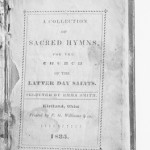 throughout the nineteenth century. For example, at a “Jubilee” celebration of the Relief Society’s fiftieth anniversary in 1892 in the Salt Lake Tabernacle, “Zina Y. W. Card … read in a very clear and distinct voice the Revelation given to Emma Smith, through Joseph the Seer … wherein Sister Emma is called an Elect Lady.” Early General Relief Society presidents were sometimes called “Elect Lady.” For instance, when Zina D. H. Young became general Relief Society president, Emmeline B. Wells (who later served as general Relief Society president) wrote to her, “I congratulate you my beloved sister on being called, to be, according to the words of Joseph the Prophet, “The Elect Lady.” (history.lds.org)
throughout the nineteenth century. For example, at a “Jubilee” celebration of the Relief Society’s fiftieth anniversary in 1892 in the Salt Lake Tabernacle, “Zina Y. W. Card … read in a very clear and distinct voice the Revelation given to Emma Smith, through Joseph the Seer … wherein Sister Emma is called an Elect Lady.” Early General Relief Society presidents were sometimes called “Elect Lady.” For instance, when Zina D. H. Young became general Relief Society president, Emmeline B. Wells (who later served as general Relief Society president) wrote to her, “I congratulate you my beloved sister on being called, to be, according to the words of Joseph the Prophet, “The Elect Lady.” (history.lds.org)
Publication Note: Section 25 was first published as chapter 26 in the Book of Commandments in 1833.
Biographical Note: Emma Hale Smith Bidamon
Born 10 July 1804 at Harmony, Susquehanna County, Pennsylvania. Married Joseph Smith, Jr., 18 January 1827 at South Bainbridge, Chenango County, New York. Nine children: Alvin, Thaddeus, Louisa, Joseph, Frederik Granger Williams, Alexander Hale, Don Carlos, male child, and David Hyrum. Adopted twins: Joseph and Julia Murdock. Assisted as scribe for the Book of Mormon. Baptized 28 June 1830 by Olive Cowdery. Confirmed member of the Church about 1 August 1830. Appointed first president of the Female Relief Society 17 March 1842. Sealed to Joseph Smith 28 May 1843 and endowed before 28 September 1843. Did not migrate west the main body of Saints in 1847. Married Major Lewis C. Bidamon 23 December 1847. No children. Died in Nauvoo, Hancock County, Illinois, 30 April 1879.
Publication note: Section 24 was first published as chapter 25 in the Book of Commandments in 1833.
Original Inscription in Revelation Book 1: John Whitmer
Revisions in Revelation Book 1: Oliver Cowdery, William W. Phelps, Sidney Rigdon, Joseph Smith, John Whitmer, Unidentified.
The first publication reflecting most redactions in this revelation is the BoC (chapter 26).
Section 26(from BoC 27 (cf. LDS D&C 26; CoC D&C 25))
Date: [4-31]July 1830
Place: Harmony, Susquehanna County, Pennsylvania
Historical Note: During the month of July 1830, Joseph Smith began to arrange and copy the revelations that he had received thus far. This he did with the assistance of John Whitmer, who was residing with Joseph and Emma in Harmony. Reference is made in section 26 to the “next conference,” which was held 26 September 1830 in Fayette, New York.
Verse 1 reads: “..and to confirming the church in Colesville…” After this revelation was received, Joseph and Oliver went to Colesville to confirm those baptized. They were unable to accomplish the confirmations at this time. Oliver then went to visit the Fayette branch of the Church (referred to in verse 1: “you shall go to the west”).
Publication Note: Section 26 was first published as chapter 27 in the Book of Commandments in 1833. Ezra Booth wrote, “I have in my possession the ’27th commandment to Emma my daughter in Zion'” (Booth to Rev. Ira Eddy, 2 Oct. 1831, Ohio Star 2 [2 Oct. 1831]: 3). Booth’s manuscript copy predated the BoC manuscript.
Original Inscription in Revelation Book 1: John Whitmer
Revisions in Revelation Book 1: Oliver Cowdery, William W. Phelps, Sidney Rigdon, Joseph Smith, John Whitmer, Unidentified.
The first publication reflecting the most redactions in this revelation is the BoC (chapter 27). Although W.W. Phelps inserted verse numbers while preparing this revelation for publication in the Book of Commandments, the verse numbers printed there are in slightly different placement from those that appear in Revelation Book 1.
Section 27 (BoC 28 (cf. LDS D&C 27; CoC D&C 26))
Date: [4-31]August 1830 or 4 September 1830
According to Newel Knight, verses 1-4 were received about 1 August 1830 and the rest being given in the September following at, Fayette, New York, but the Book of Commandments indicates that both were received 4 September. Both Newel Knight and the 1835 edition of the Doctrine and Covenants record that verses 5-18 were received in September 1830. Our 1981 and 2013 D&C only give the date of August 1830.
The 1878 edition of the LDS D&C contains the heading: “The first four verses of the following Revelation, were given through Joseph , the Seer, in Harmony, Penn., August 1830, and the remainder in Fayette, New York, September, 1830.”
The manuscript history draft is incorrect that “the first paragraph of which was written at this time, & the remainder in Septer [September] following.” Interpretations that either two separate revelations were put together to complete the text or two separate revelations were given in different months and possibly at different locations don’t seem to fit the BoC, the Evening and Morning Star, or an early manuscript of the text of this 4 September Commandment. The reason being, these early publications only have verses 1-4 ( and part of verse 5). If verses 1-4 were first received in August and the rest of the verses in September, wouldn’t you expect all of the verses to have appeared in the BoC or the Evening and Morning Star? However, they don’t. The BoC and Evening and Morning Star record only verses 1-4 and part of verse 5.
Place: Harmony, Susquehanna County, Pennsylvania.
Historical Note: During the first week of August 1830, Newel Knight and his wife went to Harmony to visit Joseph and Emma Smith. Because neither Emma nor Sally Knight had been confirmed members of the Church, the two couples decided to attend to that ordinance and partake of the sacrament. Remembering this occasion, Newel Knight recorded:
Brother Joseph set out to procure some wine for the occasion, but he had gone only a short distance, when he was met by a heavenly messenger, and received the first four verses of the revelation…
In obedience to this revelation we prepared some wine of our own make, and held our meeting, consisting of only five persons namely, Joseph Smith and wife, John Whitmer, and myself and wife. We partook of the sacrament, after which we confirmed the two sisters into the Church, and spent the evening in a glorious manner (Newel Knight Journal, Church Archives).
As a side note – Although Brigham Young said, “The Lord told Joseph that he would accept water [instead of wine],” pure wine, prepared by the Saints, was acceptable, and was not completely and officially abandoned until July 1906 (Journal of Discourses, 10:245 and 19:92; John Henry Smith Diary (July 1906), Manuscripts Division, J. Willard Marriott Library, University of Utah, Salt Lake, Utah).
Soon after this commandment was given, Joseph returned to Colesville to confirm those baptized in June who had not yet received confirmation. Afterwards he and Emma Smith went to Fayette, New York, from Harmony to live with the Whitmer family.
Publication Note: Verses 1-4 (and part of verse 5) of section 27 were first published in the Evening and Morning Star (March 1833) and reads the same as the BoC where it was published later in the same year. The BoC version is based on a handwritten manuscript of November 1831. The entire revelation was published in the 1835 edition of the Doctrine and Covenants.
Verses 1-4 were published in the Painesville Telegraph, 19 April 1831. The revelation was included with sections 20 (known as the “Articles and Covenants of the Church) and 22 (initially considered part of the “Articles and Covenants of the Church”). The editor of the Painesville Telegraph indicated that he had obtained a copy of the “Mormon Creed” from Martin Harris. The text in the Painesville Telegraph compares closely with what later appeared in the BoC, chapter 28. In the one surviving manuscript in the handwriting of Edward Partridge, the text is close to all pre-1835 versions.
Revision: 1835 D&C 50 (cf. LDS D&C 27:5-18; CoC D&C 26:2-3)
A strong indication that we presently have a heavily edited text is the phrase “Michael or Adam, the father of all, the prince of all, the ancient of day.” A letter written by Oliver Cowdery on 1 January 1834 states: “Since I came down I have been informed from a proper source that the Angel Michael is no less than our father Adam, and Gariel is Noah” (letter from Cowdery to John Whitmer, 1 January 1834, Oliver Cowdery Letterbook)
The title page of the 1835 edition states that the documents were selected from the revelations of God. Section 50 of the 1835 D&C is titles “Revelation given September, 1830” with no location given. Joseph Smith’s church history uses the 1835 text and mentions that a messenger appeared to Joseph and that there were two sections to this revelation.
The draft of Joseph Smith’s history has Newel Knight and his wife Sally visiting Harmony in early August, but it dates their arrival with Joseph “at Fayette, during the last week of August” as a conference was scheduled for 1 September 1830. Since the conference started on 26 September, the draft history is twenty-five days too early. It appears that James Mulholand changed the September date of the revelation in the 1835 D&C to “August 1830” in the manuscript history. This was done to reconcile what he had previously written concerning the Knights visiting Joseph in Harmony early in August since the second church conference had been incorrectly dated as 1 September. Mulholland moved back the visit of Newel and Sally Knight to early August when it should have been early September.
Elija & Elias
In the KJV, the proper names appear in the Hebrew form in the Old Testament (Elijah) and in Greek from in the New Testament (Elias). Elias and Elijah are the same person, the Tishbite of the Old Testament. They are not separate persons. When the Hebrew scriptures were translated into Greek in the Septuagint, the reading of Malachi 4:5 in English read: ” I will send to you Elias the Tesbite,” clearly meaning Eilijah the Tishbite.
Perhaps a plausible reading of this is, that to Joseph a number of people were considered an “Elias,” being a forerunner/preparer or a restorer. Examples: Gabriel, John the Baptist, etc. Joseph’s revision of the Gospel of Mark reads “And there appeared unto them Elias with Moses, or in other words, John the baptist and Moses; and they were talking with Jesus” (see Mark 9:4; Matt 17:3; Luke 9:30).
While Joseph was trying to make it clear to himself who various biblical personages were as he interpreted the text, he also created a number of confused passages (see D&C 76:100). He used New Testament names of Elias (Elijah) and Esaias (Isaiah).
Original Inscription in Revelation Book 1: John Whitmer
Revisions in Revelation Book 1: Oliver Cowdery, William W. Phelps, Sidney Rigdon, Joseph Smith, John Whitmer, Unidentified.
The first publication reflecting most redactions in this revelation is the March 1833 The Evening and the Morning Star.
Bibliography
Lyndon W. Cook, The Revelations of the Prophet Joseph Smith: A Historical and Biographical Commentary of the Doctrine and Covenants, Deseret Book, 1985
H. Michael Marquardt, The Joseph Smith Revelations: Text and Commentary, Signature Books, 1999
Richard P. Howard, Restoration Scriptures: A Study of Their Textual Development, Second Edition, Herald Publishing House, 1995
Steven C. Harper, Making Sense of the Doctrine and Covenants: A Guided Tour through Modern Revelations, Deseret Book, 2008
Richard Lyman Bushman, Joseph Smith, Rough Stone Rolling: A Cultural Biography of Mormonism’s Founder, Knopf, Borzoi Books, 2005
Richard E. Turley Jr., William W. Slaughter, How We Got the Doctrine and Covenants, Deseret Book, 2012
Joseph Smith, Junior – Compiler, The Parallel Doctrine and Covenants, The 1832-1833, 133, and 1835, Editions of Joseph Smith’s Revelations, The Smith-Pettit Foundation, 2009
Robin Scott Jensen, Robert J. Woodford, Steven C. Harper- Volume Editors, The Joseph Smith Papers: Revelations and Translations, Manuscript Revelation Books, The Church Historian’s Press, 2009
The Juvenile Instructor, Emma – The Elect Lady, 25 January 2008. To read more interpretations of “elect lady” click here to read rest of article.


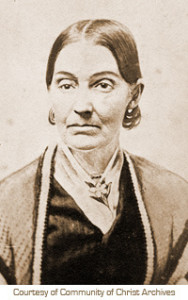
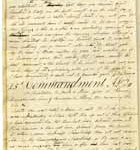
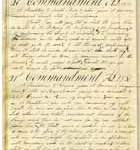
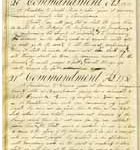
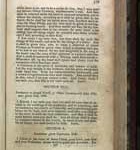



Yo, Cauliflower Ear- I’m loving these posts. Thanks so much for doing them. I’m intrigued by the rejected hymnal of David W. Rogers. I did a rudimentary Google search and found this. I wonder if it is one and the same.
http://www.hymnary.org/hymnal/CoSH1838
Yay!!! Someone finally commented on my series. Thanks Jonathan. I took a peek at the link. I bet it is the same hymnal. Very cool.
mike